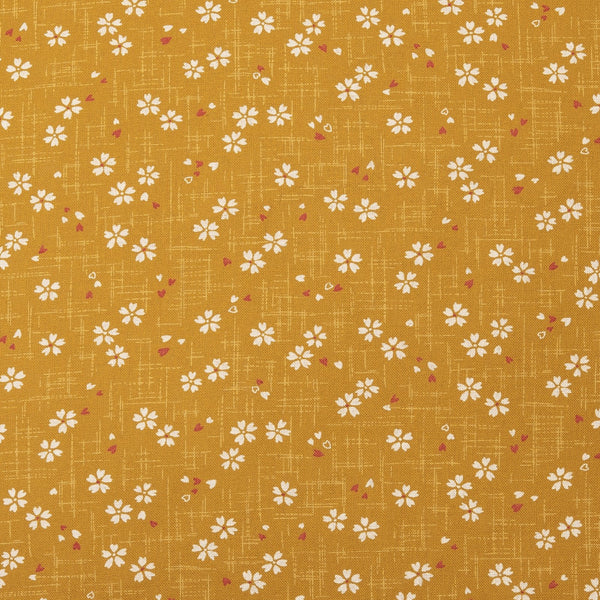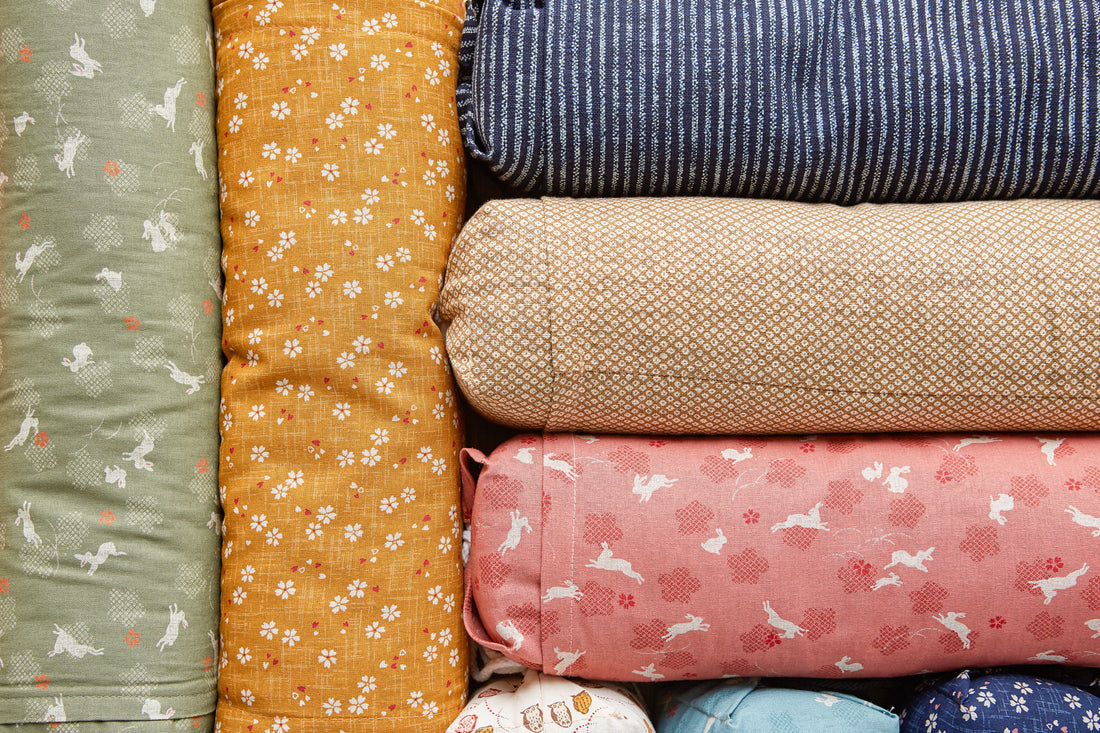From arts and cuisine to folklore and fashion, the many unique facets of Japanese culture are known and admired by people around the world. As discussed in our previous blog, The History of 7 Common Traditional Japanese Fabric Patterns, one craft that Japan has a long history in is fabric design. Each of the many fabrics we use to handmake our Japanese bedding here at J-Life is made of 100% cotton and imported from Japan. They are skillfully made using traditional designs and colors that hold significance within Japanese heritage.
In this blog, we will be looking at 5 of our Japanese fabric patterns that are all nature-themed and feature subject matter that is significant to Japanese culture, rather than a specific pattern or linework found in Japanese textile art.
Usagi (rabbit; ウサギ)
Featuring playful, leaping bunnies on two different background styles, our usagi collection includes some of our best-selling fabrics. The rabbit is a beloved creature in Japan, often kept as housepets and referenced throughout Japanese folklore, fashion, media, gaming and more. They are viewed as symbols of longevity, good luck, prosperity, and fertility.
Japan’s famed “Rabbit Island” (Ōkunoshima), located about 45 miles east of the city of Hiroshima, is a popular destination for tourists and locals alike. Additionally, one of the 12 Japanese zodiac animals (derived from Chinese zodiacs) is a rabbit.
Fun fact: 2023 is the Year of the Rabbit in the Japanese zodiac calendar!

Tombo (dragonfly;トンボ)
The dragonfly is a graceful and placid insect, boasting over 3,000 species spread across all continents except Antarctica. Sometimes referred to as the “victory insect”, the dragonfly has long been associated with the samurai (侍), a class of noble Japanese warriors that existed from the 12th – 19th centuries AD. Samurais viewed these insects as cunning, fearless beings, whose tenacity was something they found inspiring and honorable. Many pieces of armor, clothing, and weapons owned by samurai featured dragonfly motifs.
In modern times, the dragonfly is also seen as a symbol of good luck, commonly found in Japanese fabrics and art.

Sakura (cherry blossom; さくら)
The Japanese cherry blossom is a delicate pink flower that has long been a symbol of Japan - recognized around the world. The annual arrival of sakura blossoms in Japan is welcomed enthusiastically as a sign of the upcoming spring season, rebirth, renewal, and beauty. Sakura trees have been planted along many of the sidewalks, waterways, and public parks throughout urban Japan, creating a stunning canopy of pink blossoms and falling petals for a few weeks out of the year. Japanese cities will often hold festivals dedicated to the flowers’ arrival, where attendees can taste sakura-flavored treats, enjoy picnics, and go on river tours under the trees.
The cultural phenomenon of viewing sakura blossoms even has its own title: Hanami (花見) - a combination of the kanji words for “to see/watch” and the word for "flower". If you’d like to learn more, we have a blog dedicated to this topic: Hanami (花見): The Spring Tradition of Flower Watching.

Fukurou (owl;フクロウ)
Japan is home to 12 native species of owls. These majestic birds hold a comparable symbolism in Japan as they do here in the West. They are often associated with luck, wisdom, and fortune, and are recurring features in ancient Japanese legends and myths. The Ainu people, an indigenous group native to the Hokkaido region of Japan, believe in an all-seeing owl deity known as Cikap-Kamuy.
Tokyo recently became home to a number of (controversial) owl cafes, which house a variety of raptor species that patrons can interact with by petting, taking photos, and feeding the captive animals.

Saku (bloom; 咲く)
This floral print fabric features a graphic floral motif depicting 4 types of flowers that are sacred in Japanese culture: the tulip, peony, chrysanthemum, and cherry blossom (as mentioned above).
- Tulips: many tulip fields can be found across Japan. They welcome visitors from near and far to enjoy festivals hosted in their vast fields of color.
- Peony: dubbed the “King of Flowers”, the peony is commonly found in Japanese-style tattoos and art. The precise symbolism of the flower is largely dependent on context, for example: a peony on a woman’s kimono is a symbol of nobility and youth, while a peony in a man’s tattoo represents bravery, strength, and honor.
- Chrysanthemum: arguably the second most significant flower in Japanese culture (after the cherry blossom), it is a symbol of longevity and prosperity. For centuries, the Japanese royal family has used this unique flower in their official crest.
- Cherry blossom: the official flower of Japan, known worldwide for its association with Japanese culture. Each year, dozens of sakura festivals take place across Japan to celebrate the arrival of spring.


